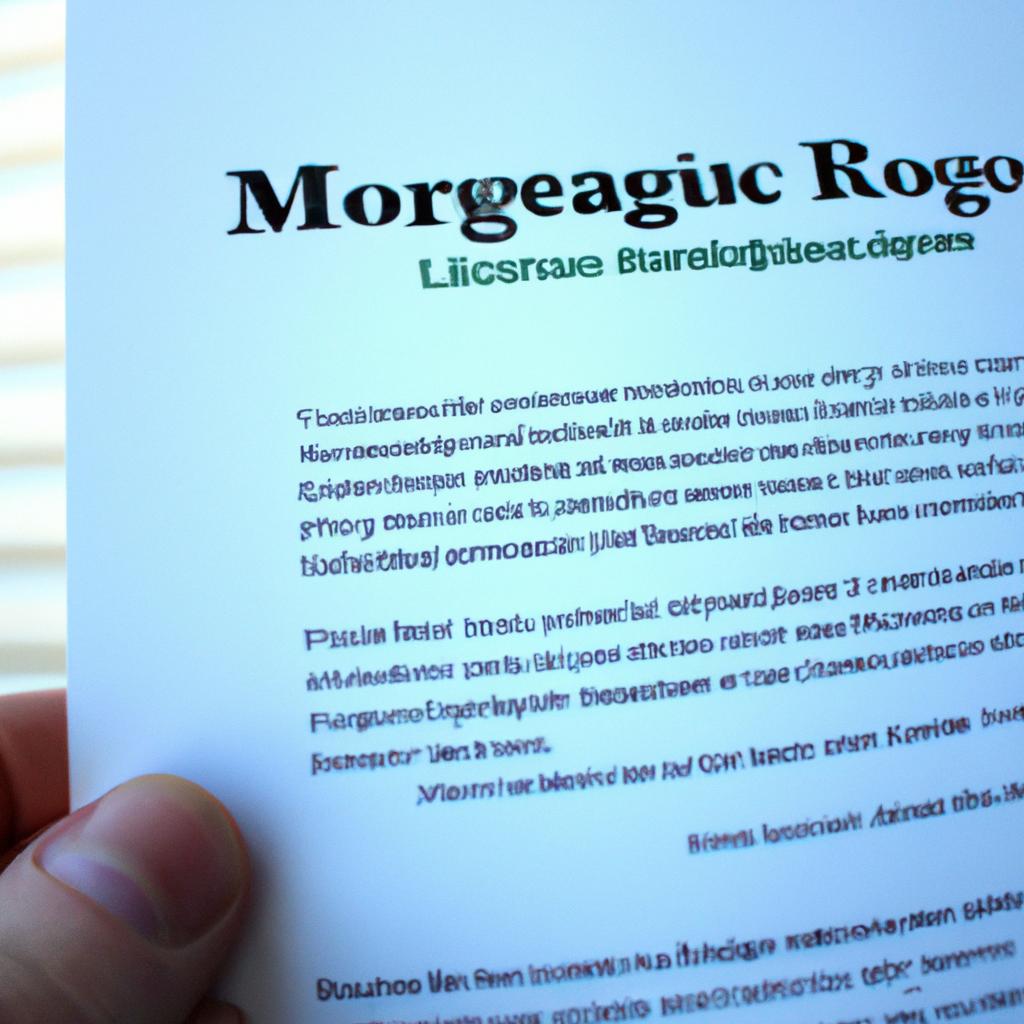In the world of real estate, securing a mortgage pre-approval is an essential step for potential homebuyers. This process involves providing certain documents to lenders in order to demonstrate financial stability and obtain a preliminary commitment for a loan. For instance, let us consider the case of Sarah, a first-time homebuyer looking to purchase her dream house. In order to begin the journey towards homeownership, she must fulfill specific requirements set by lenders in terms of documentation.
Obtaining a mortgage pre-approval not only allows homebuyers like Sarah to determine their budgetary constraints but also provides them with a competitive advantage in today’s fast-paced housing market. The purpose of this article is to shed light on the various essential documents required during the mortgage pre-approval process. By understanding these prerequisites and ensuring their timely submission, potential buyers can streamline their path towards obtaining financing for their desired property effectively. From income verification to credit history documentation, each requirement serves as an important ingredient that contributes to the overall evaluation conducted by lenders before granting pre-approvals.
Proof of income
Proof of income is an essential requirement when applying for a mortgage pre-approval. Lenders need to assess your ability to repay the loan, and proof of income provides them with crucial information about your financial stability. This section will outline the documents typically required as proof of income and explain why they are necessary.
To illustrate the importance of these documents, consider the case of John, a prospective homebuyer. John works as a software engineer and earns a steady monthly salary from his employer. He decides to apply for a mortgage pre-approval to determine how much he can afford to borrow. The lender requests specific documents related to his income, helping them evaluate his eligibility for a loan.
When providing proof of income, there are several key items that lenders commonly request:
- Pay stubs: These provide details on your current employment status, including your gross income, deductions, and taxes paid.
- W-2 forms: These tax documents summarize your yearly earnings and indicate any withholdings made by your employer.
- Income tax returns: Typically requested for at least two years, tax returns show your overall financial situation and verify consistent income over time.
- Bank statements: These reveal regular deposits into your account and may include evidence of additional sources of income such as investments or rental properties.
In order to evoke an emotional response in the audience during this process, it is important to recognize that gathering all these documents can be time-consuming and potentially stressful. However, keep in mind that submitting accurate and comprehensive proof of income increases your chances of obtaining a favorable mortgage pre-approval.
To further understand what might be expected from you when providing proof of income, let’s look at the following table:
| Document | Purpose | Required Duration |
|---|---|---|
| Pay stubs | Verify current employment status | Recent 2 months |
| W-2 forms | Validate yearly earnings | Past 2 years |
| Income tax returns | Confirm consistent income | Past 2 years |
| Bank statements | Identify additional sources of income | Recent 3-6 months |
In conclusion, proof of income is a vital component of the mortgage pre-approval process. By submitting documents such as pay stubs, W-2 forms, income tax returns, and bank statements, you provide lenders with evidence of your financial stability and ability to repay the loan. The next section will discuss another essential requirement: employment verification.
Employment verification
Having established proof of income, the next crucial step in the mortgage pre-approval process is employment verification. Lenders require this information to assess your stability and ability to meet monthly mortgage payments. Let us delve into the key aspects involved in verifying your employment.
Example:
Consider a hypothetical scenario where Jane Smith applies for a mortgage pre-approval. She provides all necessary documents related to her income but lacks proper employment verification. This omission raises concerns for lenders regarding her job stability, potentially affecting her chances of obtaining a favorable mortgage offer.
To ensure accurate employment verification, lenders typically employ various methods such as contacting employers directly or requesting official documentation. The following are essential requirements you may encounter during this stage:
- Employer Contact: Lenders often reach out to employers directly via phone or email to verify your current employment status, position held, length of service, and salary details.
- Pay Stub Validation: Your recent pay stubs serve as tangible evidence of consistent income. These documents confirm not only your earnings but also any additional benefits received through your employer.
- Tax Returns: Providing copies of your tax returns allows lenders to cross-reference your declared income with official records filed with government authorities.
- Written Employment Verification: Some lenders may request an official letter from your employer confirming your employment status, duration with the company, and salary particulars.
The importance of thorough employment verification cannot be overstated; it helps protect both borrowers and lenders by ensuring transparency and financial responsibility throughout the mortgage process:
- Provides peace of mind for lenders knowing that borrowers have stable sources of income
- Assures borrowers that their loan application is being evaluated fairly based on accurate information
- Helps prevent fraudulent activities by detecting false claims about income or employment history
- Establishes trust between all parties involved, leading to smoother transactions and reduced risk
Table Example (Employment Verification Checklist):
| Requirement | Method | Purpose |
|---|---|---|
| Employer Contact | Phone or Email | Confirm employment status and salary details |
| Pay Stub Validation | Submission of recent pay stubs | Verify regular income consistency |
| Tax Returns | Submit copies of tax returns | Cross-reference declared income with official records |
| Written Employment Verification | Request official letter from employer | Obtain written confirmation of employment details |
Once your employment has been verified, the next critical aspect in the mortgage pre-approval process is assessing your credit history.
Credit history
Employment Verification
After carefully reviewing your employment history and income stability, the next step in mortgage pre-approval is verifying your employment. Lenders require this information to assess your ability to repay the loan. Let’s delve into what you can expect during the employment verification process.
To illustrate, let’s consider a hypothetical scenario involving Sarah, who recently applied for a mortgage pre-approval. Sarah works as a marketing manager at XYZ Corporation and has been with the company for five years. The lender will contact her employer directly to confirm her position, salary, and length of employment.
During the employment verification process, lenders typically look for specific details that demonstrate financial stability. Here are some common requirements:
- Proof of Employment: You may be asked to provide recent pay stubs or an offer letter from your current employer.
- Length of Employment: Lenders prefer borrowers who have stable job tenure. They generally seek applicants who have been employed consistently for at least two years.
- Salary Confirmation: Your lender may request documents such as W-2 forms or tax returns to verify your annual income.
- Future Income Prospects: If you receive commission-based income or bonuses, proof of consistent earnings over time may be necessary.
Consider the following table highlighting additional factors that lenders often evaluate during the employment verification process:
| Factors | Impact |
|---|---|
| Job Stability | Demonstrates reliability |
| Consistent Income | Indicates steady cash flow |
| Potential Promotions | Assesses future earning potential |
| Transferable Skills | Evaluates adaptability and employability |
By thoroughly assessing these criteria, lenders aim to gauge whether you possess a stable source of income to afford monthly mortgage payments without undue financial strain.
As we move forward in our discussion about essential documentation required for mortgage pre-approval, it is crucial to transition smoothly toward understanding another vital aspect — your bank statements. By examining these statements, lenders gain insight into your financial habits and assess the overall risk associated with granting you a mortgage loan.
Bank statements
Having reviewed the credit history and ensuring its reliability, another crucial aspect that lenders consider when evaluating mortgage pre-approval applications is an individual’s bank statements. By examining these documents, financial institutions gain insight into a borrower’s financial stability, spending patterns, and overall ability to meet their loan obligations.
Paragraph 1:
To illustrate the importance of bank statements in the mortgage pre-approval process, let us consider a hypothetical case study. Imagine John, a potential homebuyer looking for mortgage financing. John applies for pre-approval at his chosen lender and provides his bank statements as part of the application package. These statements offer detailed information about John’s income and expenses over several months, which allows the lender to assess whether he has sufficient funds to cover down payments, closing costs, monthly mortgage payments, and other associated fees.
Paragraph 2 (Bullet Point List):
Bank statements provide valuable insights into an applicant’s financial habits and can affect their chances of receiving a mortgage pre-approval. Here are some key factors that lenders typically analyze when reviewing bank statements:
- Consistency in deposits: Lenders look for regular deposits as it demonstrates a stable income source.
- Stable account balances: Maintaining steady or increasing balances indicates good money management skills.
- Large withdrawals or transfers: Significant transactions may raise concerns about an individual’s ability to handle unexpected expenses.
- Overdrafts or bounced checks: Instances of overdrawing on accounts suggest poor budgeting practices.
Paragraph 3 (Table):
| Factors Considered | Impact on Pre-Approval |
|---|---|
| Regular Deposits | Positive |
| Steady Balances | Positive |
| Large Transactions | Potential Concern |
| Overdrafts/Bounced Checks | Negative |
The table above summarizes how each factor influences an applicant’s chances of obtaining a pre-approved mortgage. It is important to note that while negative factors may not automatically disqualify someone from pre-approval, they can significantly impact the lender’s decision-making process.
Evaluating a borrower’s bank statements is just one aspect of the mortgage pre-approval process. Another critical requirement lenders typically assess is proof of assets. By examining an applicant’s assets, financial institutions gain further reassurance regarding their ability to afford and maintain a mortgage loan.
Proof of assets
Proof of Assets
In the previous section, we discussed the importance of bank statements in the mortgage pre-approval process. Now, let’s shift our focus to another crucial aspect: proof of assets. Demonstrating your financial stability and ability to cover down payments and closing costs is essential for obtaining a mortgage pre-approval.
To illustrate this point, consider John and Sarah, a hypothetical couple looking to purchase their first home. They have saved diligently over the years and now need to provide evidence of their substantial assets as part of the pre-approval requirements. This serves as reassurance to lenders that they are financially capable.
When it comes to proving your assets, there are several key documents you should gather:
- Investment Statements: Include any statements from stocks, bonds, mutual funds, or other investments you hold.
- Retirement Account Statements: Provide documentation for any retirement accounts such as 401(k), IRA, or pension plans.
- Real Estate Holdings: If you own additional properties or land, provide supporting paperwork like deeds or rental agreements.
- Other Valuables: Consider including appraisals or valuations for high-value possessions such as vehicles, artwork, or jewelry.
By presenting these documents along with your bank statements, you strengthen your case for mortgage pre-approval. Lenders will see that you have sufficient assets to back up your financial commitments and are therefore less likely to view you as a risky borrower.
| Assets | Value | Documentation |
|---|---|---|
| Investments | $150,000 | Statements |
| Retirement Accounts | $300,000 | Statements |
| Rental Property | $500/month | Lease Agreement |
As illustrated in the table above (which outlines John and Sarah’s asset value alongside corresponding documentation), providing an organized summary can help streamline the approval process while also evoking confidence in potential lenders.
In transitioning into our next section, it is important to note that while bank statements and proof of assets are crucial components in the mortgage pre-approval process, they must be accompanied by proper identification documents. Let’s explore this next step in further detail.
Identification documents
Proof of Assets
Transitioning from the previous section on proof of assets, it is important to highlight that mortgage pre-approval requirements extend beyond just verifying the borrower’s financial holdings. Lenders also require certain identification documents to assess an individual’s creditworthiness and evaluate their ability to repay the loan. By providing these essential documents, borrowers can expedite the pre-approval process and increase their chances of securing a mortgage.
To illustrate this point further, let us consider a hypothetical scenario involving John, who is looking to purchase his first home. As part of his mortgage application, John must submit various identification documents alongside proof of assets. These documentation requirements are intended to ensure that lenders have accurate information about John’s financial standing and identity. Failure to provide these documents may delay or even jeopardize John’s chances of obtaining pre-approval.
When preparing for a mortgage pre-approval, individuals should gather the following identification documents:
- Valid Photo Identification: A government-issued ID such as a driver’s license or passport serves as proof of identity.
- Social Security Number (SSN) Verification: An SSN card or official letter from the Social Security Administration confirms an individual’s unique identifier in the United States.
- Proof of Residence: Documents like utility bills or rental agreements establish where an applicant currently resides.
- Employment Authorization Documentation: Non-U.S citizens need to provide valid work permits or visas indicating authorization to work in the country.
Including visual aids can enhance comprehension and engagement with complex information. The table below summarizes the required identification documents needed for mortgage pre-approval:
| Required Identification Documents | Example |
|---|---|
| Valid Photo Identification | Driver’s License |
| Social Security Number (SSN) | SSN Card |
| Proof of Residence | Utility Bill |
| Employment Authorization Documentation | Work Permit |
By presenting these identification documents, borrowers demonstrate their commitment to the mortgage application process and provide lenders with the necessary information to evaluate their creditworthiness. It is crucial for individuals seeking pre-approval to diligently gather and submit these essential documents in order to streamline the approval process.
In summary, beyond proof of assets, verifying one’s identity and legal status are critical components of obtaining a mortgage pre-approval. By providing valid photo identification, Social Security Number verification, proof of residence, and employment authorization documentation when applicable, prospective homeowners can ensure that they meet lenders’ requirements and increase their chances of securing a mortgage loan.
 SMI Loan
SMI Loan



